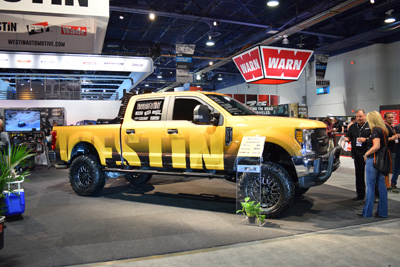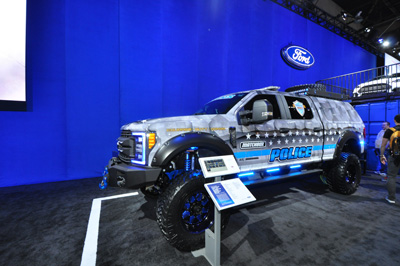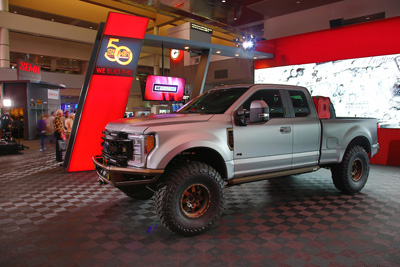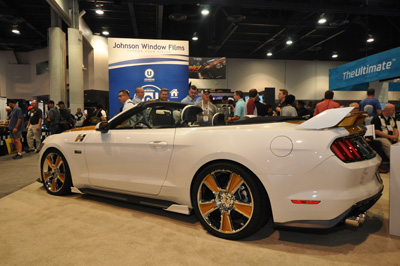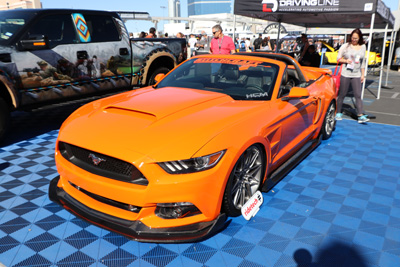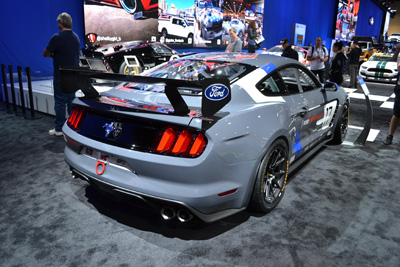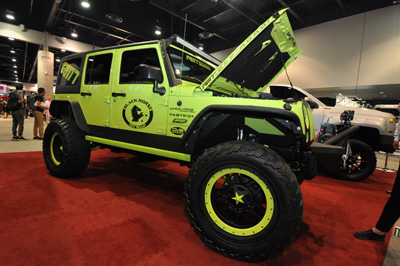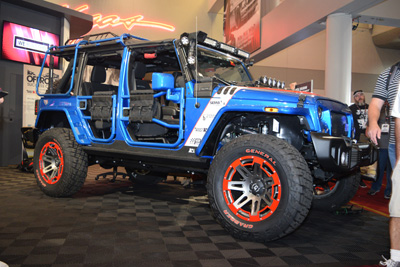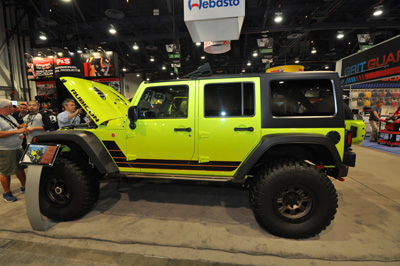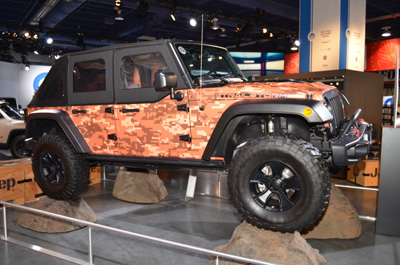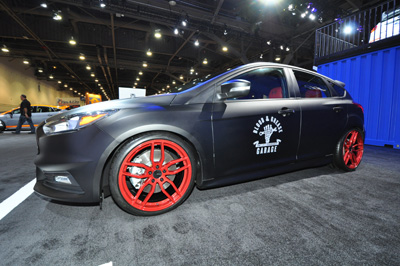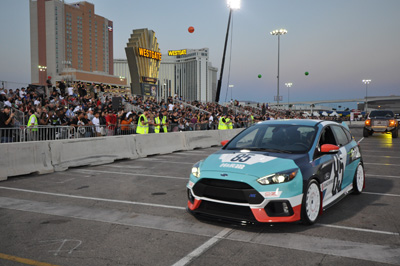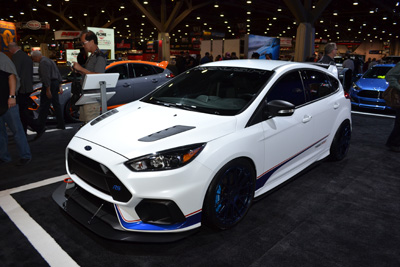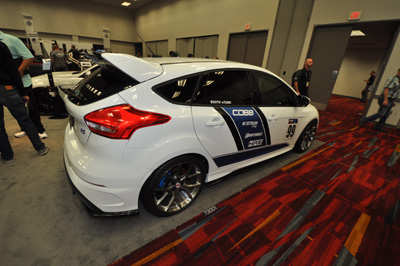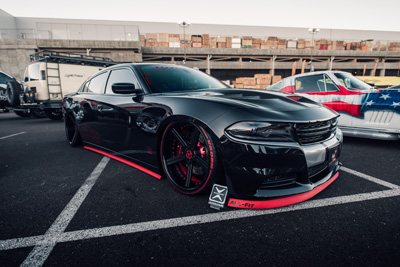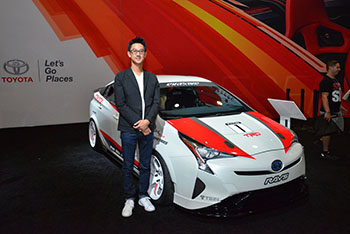EVENTS
By Clint Simone
The 2016 SEMA Award
The Hottest, Most Specialty-Equipment-Friendly Vehicles From the 2016 SEMA Show
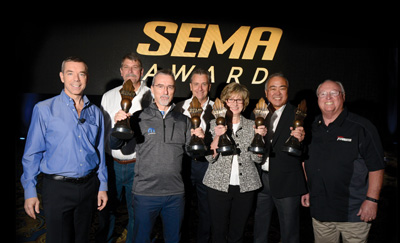
Pietro Gorlier (center left), head of parts and service for MOPAR FCA-Global, and Judy Curran (center right), Ford director for engineering, planning and strategy, accept their SEMA Awards from SEMA executive leadership for the SEMA Show’s hottest-trending vehicles across several categories. Awards went to the Ford Mustang as the Hottest Coupe, the Dodge Charger as the Hottest Sedan, the Ford Focus as the Hottest Hatch, the Jeep Wrangler as the hottest 4x4-SUV, and the Ford F-Series as the Hottest Truck. |
|
More than 2,400 exhibitors from the 2016 SEMA Show voted to determine this year’s SEMA Award winners—a forward-looking honor that identifies the exhibitors’ choices about the hottest new and emerging vehicles and guides consumers toward the most accessory-friendly platforms on the market. For 2016, Ford and MOPAR were chosen as the two most popular OEMs, with Ford winning in three categories and MOPAR winning the remaining two.
The ’16 F-Series truck was named Hottest Truck; the ’16 Ford Mustang was named Hottest Coupe, and the Ford Focus was named Hottest Hatch. Rounding out the victors was MOPAR’s Jeep Wrangler, winning the Hottest 4x4-SUV award, and the Dodge Charger as Hottest Sedan.
“The SEMA Show is the place where the newest and most innovative aftermarket products debut,” said Chris Kersting, SEMA president and CEO. “And the SEMA Show exhibitors are the innovators and visionaries who help guide future trends in the industry.”
The SEMA Award heightens awareness for aftermarket products, which can improve sales at dealerships. It also points to the benefits of the partnership between automakers and the aftermarket manufacturers as they collaborate to offer specialized parts for enthusiast buyers who consider ’16–’17 models.
The following pages highlight some of the ways 2016 SEMA Show exhibitors have already enhanced these platforms, along with insights into why the vehicles are energizing the aftermarket.
’16/’17 F-Series, 2016 SEMA Show Hottest Truck
Westin Automotive
“We began work on this truck in mid-September and had from then until heading out for the SEMA Show in Las Vegas to make it all come together,” said Alicia Castillo, marketing manager for Westin Automotive.
Westin’s build for its SEMA Show booth, located in the upper south hall of the Las Vegas Convention Center, was designed to be both practical and Show-worthy. “We themed our Super Duty to appeal to the everyday truck owner who works hard and plays hard in his/her truck. We worked hand-in-hand with Josh Daley of Daley Visual to come up with the eye-catching color scheme,” Castillo explained.
The F-350 featured a host of Westin products, including the company’s HD headache rack and Brute crossover toolbox, BedSafe box and BDX drop-step bars. Westin’s truck rode on 37-in. Interco tires and featured a 6-in. Fabtech lift. Additional features included MagnaFlow exhaust and a Line-X spray-in bed liner.
Castillo explained the selection process in building the truck for the SEMA Show: “All of the products used on this build really gave the truck the custom look that truck lovers love.”
Mickey Thompson
Mickey Thompson, in conjunction with X-Treme Toys, designed and built this ’17 F-250 called “Project Tall Boy 40” for its booth at the 2016 SEMA Show. The name stemmed from an essential part of the truck’s identity—its 40-in. tires. The big 40s were new to the Mickey Thompson lineup and were wrapped around another new product for the company: 20-in. Sidebiter II wheels.
According to the team at Mickey Thompson, “Project Tall Boy is the ultimate truck for high-powered action.” An aFe Power cold-air intake and cat-back exhaust boosted engine breathing, while a Fabtech suspension and Mag Hy-Tech front and rear differential covers added reliability and off-road capability.
Tall Boy 40 was not just about brawn; its exterior was packed with upgrades. A Custom Paintin’ Place paint job, Fab Fours front and rear Vengeance-series bumpers, a T-Rex custom grille, an ARB on-board air system and Bushwacker fender flares were part of the package as well. A full Katzkin leather interior and a Kicker subwoofer were added inside, in addition to an S-Pod 12-volt power distribution system.
Skyjacker Suspensions
The Skyjacker Suspensions team showcased the company’s unique array of products and partnerships with other major companies in the industry such as Katzkin, Lund Industries and Kicker Audio. The company’s display F-350, titled “MBX350 Matchbox Police,” was designed to be a “lifesize toy truck that acts as a fully functioning police/tactical unit.”
Skyjacker started with a ’17 Ford F-350 4x4 XL Crew Cab equipped with a 6.7L V8 PowerStroke turbodiesel engine. Added to the powertrain was a MagnaFlow performance exhaust system. Following the powertrain, chassis modifications included a Skyjacker Suspensions 8.5-in. four-link lift kit with rear leaf springs, LeDuc-series coil-over front shocks, M95 monotube rear shocks and Silver dual steering stabilizers. Fab Fours premium front and rear bumpers, a Legacy 54-in. super LED light bar and Bushwacker pocket-style fender flares added additional rugged, police-inspired touches.
The truck was loaded with personal styling details to fit the active law-enforcement lifestyle, both inside and out. As Skyjacker put it, “MBX350 is built to protect and serve the men and women who protect and serve each of us.”
’16/’17 F-Series, 2016 SEMA Show Hottest Truck
SEMA Garage
“The SEMA Garage Super Duty perfectly demonstrates the potential of the SEMA Garage Tech Transfer portfolio,” said Jim Moore, SEMA senior director of OEM relations.
The base vehicle for the project was a ’17 Ford F-250 Super Duty and was built at the SEMA Garage facility in Diamond Bar, California, using tools within the Garage, such as the Tech Transfer program. The end result, according to Moore, was “an example of how the aftermarket community can create seamless product integration through the use of advances in manufacturing tools such as OEM CAD files, 3D FARO scanning and 3D printing.”
The Super Duty featured several parts and accessories designed by the SEMA Garage, including 10-in. fenders and a 3D-printed front grille housing. Icon Vehicle Dynamics provided 3-in. external-bypass adjustable shocks and 2-in. front coil springs as well as a four-link front suspension.
aFe Power added a cold-air intake and filter in addition to a CARB-certified ECU tune and a DPF-back exhaust system. Additional accessories included Baja Designs LED lighting, an ARB onboard twin air compressor and a powered fridge/freezer.
The F-250 rode on 40-in. Toyo tires wrapped around 17-in. Raceline wheels. A Hellwig front swaybar and Lund Powerstep XL running boards completed the package.
’16/’17 Ford Mustang, 2016 SEMA Show Hottest Car
GSS Supercars
GSS Supercars, maker of performance musclecars and supercars, brought its latest creation, the ’17 Hurst GSS Supercars K-Code Mustang to the SEMA Show. The custom build, designed and built by GSS Supercars, came together with a variety of exterior features, including a custom front fascia, custom grilles with perforated metal-backed urethane honeycomb mesh, a twin-intake hood, custom Hurst Gold body graphics/paint and much more.
“The paint and design scheme are a nod to George Hurst, who loved the color gold,” said Larry Weiner, GSS Supercars spokesperson. “We worked with Hurst throughout the entire process and developed a car that is more than just a hot rod. It is a gentlemen’s hot rod, one that is elegant as well.”
Beyond the cosmetic upgrades, GSS added some power to the already potent Ford Coyote 5.0 engine. A Kennebell supercharger brought the total horsepower figure to 750.
“All of the performance and aesthetic upgrades make the Mustang special, but it is also special in its rarity,” Weiner said. “These are all limited-edition models, with only 50 total cars being made in both coupe and convertible form.”
Roush
Roush Performance displayed a new take on a car that the company first brought to the 2007 SEMA Show—the P-51 Mustang, a modern tribute to the World War II-era P-51 fighter plane. The Roush Mustang was built with the Mustang’s 5.0 engine, then power stroked up to 727 hp via an Eaton supercharger and breathing enhancements such as a Roush three-stage performance exhaust.
The silver body color on the Mustang was accented with matte military green features and a red/yellow checkered badge. Both are nods to the 357th Fighter Group—an air combat unit active during World War II.
’16/’17 Ford Mustang, 2016 SEMA Show Hottest Car
Stitchcraft
Starting with a BASF pearl candy orange paint job, the ’17 Stitchcraft Mustang’s exterior was specially made with Forgeline 20-in. wheels, a HCM Sigala carbon-fiber body kit, Modern Image graphics, a Classic Design light bar and a Ford Licensed Accessories’ lighted pony grille.
Stitchcraft created a unique interior with Katzkin leather seat upholstery, an Alpine electronics system, a Mono power amp and XS Power batteries.
Speaking to the design inspiration, Ford explained, “This pearl candy orange Mustang concept will set enthusiasts’ hearts ablaze with a combination of great handling and performance, along with an exotic look and feel that infuse the drop-top with personality and flare.”
Ford
Ford debuted its latest extreme Mustang, the GT4 race car, at the 2016 SEMA Show. The new Mustang was based heavily on the GT350R-C, making the GT4 a competition-ready vehicle able to compete in IMSA, Continental Tire Sports Car Challenge, Pirelli World Challenge GTS, European GT4 and more.
Highlights of the specialty Mustang included a six-speed Holinger paddle-shift transmission, a dry-sump oiling system, a ZF twin-plate clutch and flywheel and the engine from a Shelby GT350R. Inside, the race-car ethos of lightweight was carried out with a FIA-compliant rollcage, a Bosch Motorsport engine control and a MoTec dash logger. The GT4 rode on Forgeline 18-in. wheels wrapped in Continental racing-slick tires.
’16/’17 Jeep Wrangler, 2016 SEMA Show Hottest 4x4-SUV
Rocky Mountain Truckworks/Vanworks Inc./Black Horse/Xanatos Automotive
“This was a very exciting build for us and a wonderful opportunity to not only showcase some wonderful vendors but also allow our technicians and design team to really exhibit their skills,” said Scott Duda, production manager for Rocky Mountain Truckworks/Vanworks Inc.
The Wrangler JK was displayed in the Black Horse Automotive booth at the SEMA Show and showcased a variety of upgraded off-road features and cosmetic enhancements.
Xanatos Automotive provided 50-in. and 30-in. LED light bars in addition to Wrangler grille inserts. A Fabtech Motorsports 5-in. short-arm crawler system, Wheel-1 37-in. tires, Wheel Pros Rock Star 3 wheels, MagnaFlow performance exhaust and DV8 Off Road hood, bumpers, fenders and winch made up just a few of the exterior modifications.
“Our design team worked with several other companies to build a truly one-of-a kind vehicle that showcased the newest industry trends and designs,” Duda concluded.
Omix-ADA/Rugged Ridge
Omix-ADA showcased a custom-built Jeep Wrangler JK Unlimited in support of SEMA Cares, marking the fourth time the company has partnered with SEMA and its charity efforts. All proceeds from the Wrangler will benefit Victory Junction Camp—a camp dedicated to enriching the lives of children affected by serious illness or chronic medical conditions.
The Wrangler was built at Petty’s Garage in Level Cross, North Carolina. The owner of Petty’s Garage, NASCAR legend Richard Petty, was directly involved with the build, making the Wrangler an all-around special project.
The ’16 Wrangler JK came stock and was ultimately transformed via a full array of Rugged Ridge parts and accessories.
’16/’17 Jeep Wrangler, 2016 SEMA Show Hottest 4x4-SUV
Webasto
Webasto, maker of aftermarket sunroofs and heating/cooling accessories, displayed a custom ’16 Jeep Wrangler JK at the SEMA Show. The Jeep was modified with an array of specialty-equipment products, including a host of the company’s own. A Webasto ThrowBack soft folding fabric roof, a fridge freezer, cargo slides, a cargo surround and security system and a Trail Oven were all included in the build.
In addition to the Webasto parts and accessories, components such as 37-in. BFGoodrich tires, America’s Most Wanted 4x4 control arms and a Dynomax quiet-crawler exhaust added to the Jeep’s off-road capabilities. The package was completed with a Katzkin Tuscany leather interior.
MOPAR
According to MOPAR, the Jeep Trailstorm concept vehicle is the “ultimate Jeep Wrangler for exploring off the beaten path.” Its off-road capability was enhanced via a collection of Jeep Performance Parts, including 17-in. concept off-road wheels wrapped in 37-in. tires, a 2-in. lift kit with Jeep Performance Parts/Fox shocks, and a Rubicon winch.
Exterior accessories added to the Trailstorm included a Satin Black grille, LED headlamps and fog lights, high-top fenders, a power-dome vented hood, MOPAR off-road rails, a big-brake kit and steel front and rear bumpers.
Inside, the Trailstorm featured all-weather floor mats, Katzkin seat covers, a Jeep cargo management system and modified interior trim and accents.
’16/’17 Ford Focus, ’16 SEMA Show Hottest Hatchback
Blood & Grease
Aaron Vaccar and his Blood & Grease company partnered with Ford and created the “Do-It-Yourself” Focus ST. The hot-rodded hatchback was themed to represent how turbocharged tuners are today’s modern hot rods. The build called attention to the idea that today’s generation of car guys carries the same amount of passion as those in previous generations.
The Focus featured matte-metallic paint, brushed-metal three-piece wheels and an aggressively lowered suspension stance. Special performance items such as a front-mounted intercooler and black-tip exhaust were included as prototype products made specially for the SEMA Show. Rounding out the exterior were RGBW Demon Eye headlights.
The interior of the Focus ST was designed and built with custom Alea leather, Blood & Grease bespoke upholstery and a Grip Royal Blood & Grease-edition steering wheel.
H&R Customs
Drawing inspiration from past Ford rally competition cars, the H&R Customs Focus RS was designed to be a go-getter on all terrain types. Specific chassis and exterior modifications made the RS a true rally competitor. Starting with the chassis, this RS wore an H&R Custom RSS Performance coil-over suspension with H&R Trak+ wheel spacers.
“The coil-over suspension means each coil-over shock is fine-tuned with a progressive-rate spring to ensure better handling and premium ride comfort,” Ford explained.
The exterior of the Focus is equally inspired, with graphics done by Stanceworks demonstrating the Ford Rally heritage. A Ford European RS rear diffuser, hood vents and a Triple R Composites front splitter and side skirts completed the RS as a Rally-inspired machine.
Roush
According to the Ford builders, the Roush Ford Focus RS concept “combines the incredible power and handling of the Ford hatchback with rich Roush Performance racing heritage and world-class styling.” The collaboration of the two companies produced an RS with a 500hp output and a long list of modifications.
The standard 2.3L I-4 EcoBoost engine was upgraded with a Roush Performance-enhanced cooling system, engine calibration and short-block assembly. PFC slotted brake rotors were featured on all four corners along with Roush TrakPak lightweight forged wheels.
Additional exterior modifications included a Roush TrakPak front splitter, rear wing, side splitters, diffuser and hood heat extractors.
Cobb Tuned
“The Cobb Tuned Ford Focus RS featured airflow modifications necessary for additional power, with Nostrum Energy stepping up to deliver a fueling solution to match,” said Tadd Crayton, director of marketing for Cobb Tuning. “Power, chassis and aesthetic touches delivered a look that the Ford RS deserves.”
Cobb’s ’16 Ford Focus RS, displayed in the Nostrum Energy booth, was designed as a performance-upgraded version of the already capable Ford Focus RS. Cobb upgraded the RS with its Accessport V3, a cat-back exhaust, a high-flow filter, a hard pipe kit, a rear motor mount, a short shift plate and Cobb/Nostrum K-DI injectors.
Exterior modifications included a Maxton Design spoiler cap, rear side splitters, side-skirt diffusers and a front splitter V4. Wrap Dynamics covered the car in rally-inspired graphics.
“This ’16 Focus RS has been dialed up in the performance department, enabling it to conquer the strongest of rivals,” said Crayton.
’16/’17 Dodge Charger, ’16 SEMA Show Hottest Sedan
The inaugural Hottest Sedan SEMA Award went to MOPAR and its ’16/’17 Dodge Charger. A first for the SEMA Award, the Hottest Sedan recognizes the best four-door sedan platform for vehicle modification within the specialty-equipment marketplace. This year, voting manufacturers signaled that they were excited about the potential for the Charger as raw material for upgrades and a future driver of specialty-equipment investment. Pietro Gorlier, head of parts and service for MOPAR FCA-Global, put it this way: “The SEMA Show and SEMA members play a critical role in identifying the hottest trends and rides in the vehicle customization industry, which is why winning a SEMA Award represents an important recognition for our company.”
Family Customs
One of the best examples of the new Dodge Charger at the 2016 SEMA Show was a Star Wars-themed example from Nick Lopez and his team at Family Customs. The Charger, which Nick named #VadarCharger, was derived from Lopez’s two childhood loves—the Star Wars brand and cars.
“Nothing goes together better than an American classic like Star Wars combined with the explosiveness and excitement of modern American musclecars,” he said.
The build featured extensive detail work, including 22-in. Triumph forged wheels, an AccuAir suspension, custom paint work from Exclusive Image Autobody, and a Corsa Performance cat-back X-pipe exhaust. Custom interior details included a Star Wars mural covering the headliner created by Wuzu graphic headliners, Katzkin leather seats and a full Kicker audio system.



